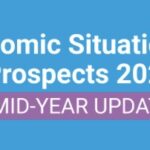As 2025 approaches its midpoint, the global economic outlook is increasingly defined by heightened uncertainty, disruptive technological change, and fragmented geopolitical landscapes. Yet, amid this turbulence, South Asia—particularly India—continues to offer a relatively stable and promising growth narrative.
The latest Chief Economists Outlook, released today by the World Economic Forum (WEF), highlights this divergence with clear implications for policymakers, investors, and business leaders.
Global Outlook: A Structural Shift, Not a Temporary Shock
The prevailing sentiment among leading economists surveyed by the WEF is that the current state of the global economy is not a cyclical downturn but a deeper, more permanent structural transformation. A decisive 79 per cent of respondents believe recent geo-economic shifts—spurred by protectionist trade policies, rising public debt, and the strategic recalibration of global supply chains—represent a long-term change in how the global economy functions.
“Policymakers and business leaders must respond to heightened uncertainty and trade tensions with greater coordination, strategic agility and investment in the growth potential of transformative technologies like artificial intelligence,” said WEF’s Managing Director, Saadia Zahidi. “These steps are essential for navigating today’s economic headwinds and securing long-term resilience and growth.”

The report underscores a climate of pervasive uncertainty, with 82 per cent of economists describing global economic conditions as “exceptionally high” in volatility. This sentiment is reinforced by 87 per cent of respondents who believe that current U.S. trade and fiscal policies are delaying strategic business decisions globally and elevating the risk of recession.
North America faces particularly muted growth expectations, while Europe, despite a rare glimpse of optimism due to anticipated fiscal easing (especially in Germany), continues to face headwinds. Public debt is emerging as a major concern across developed economies, with 86 per cent of economists expecting governments to rely more heavily on borrowing to fund surging defense expenditures—raising questions about future fiscal sustainability.
Artificial Intelligence: Growth Driver or Disruption Catalyst?
Artificial Intelligence (AI) looms large as both a potential savior and a disruptor of economic growth. A majority of economists expect AI to deliver a modest boost to global GDP—46 per cent project gains of 0–5 percentage points, while 35 per cent foresee increases of 5–10 points over the next decade. The primary growth mechanisms identified include task automation, faster innovation, and workforce augmentation.
However, the optimism is tempered by serious structural risks. Nearly half of the economists surveyed (47 per cent) anticipate net job losses due to AI, compared to just 19 per cent who predict net job creation. Moreover, 53 per cent cite the risk of AI-fueled disinformation as the top threat, followed closely by the rise of market monopolies and the destabilization of existing business models.
Economists call for proactive investment in AI infrastructure (89 per cent), talent mobility (80 per cent), and workforce reskilling (75 per cent) to mitigate these risks and unlock long-term productivity gains.
Trade Policy and Global Investment Under Pressure
Trade policy remains the most unpredictable economic variable in 2025, with 97 per cent of economists identifying it as a key area of concern. The combination of escalating tariffs, regional trade realignments, and retaliatory measures is expected to reduce trade volumes (70 per cent), slow GDP growth (68 per cent), and dampen foreign direct investment (62 per cent).
The implications for emerging markets are mixed: while some countries may benefit from supply chain diversification, others could struggle with trade displacement, particularly if new routes bypass traditional hubs.
South Asia: A Regional Outlier with Positive Momentum
Against this sobering global backdrop, South Asia—led by India—has emerged as a notable outlier. One-third of chief economists surveyed express strong or very strong growth expectations for the region in the second half of 2025, making it the most optimistic regional outlook globally.
India, which accounts for the lion’s share of South Asia’s economic output, is forecast by the International Monetary Fund to grow by 6.2 per cent in 2025 and 6.3 per cent in 2026. These projections are supported by resilient PMI data and renewed export momentum following the conclusion of a significant trade agreement with the United Kingdom. The strength of domestic consumption, ongoing digitalization efforts, and an improving investment climate are also seen as contributing to India’s robust medium-term trajectory.
Nevertheless, regional challenges persist. Military tensions between India and Pakistan in early May have heightened geopolitical risk perceptions. Inflationary pressures remain elevated, and economists are watching closely for signs of rerouting in Chinese exports that could impact local competitiveness and trade balances.
Strategic Takeaways: Navigating a Multipolar, Uncertain Economy
The WEF’s findings reinforce the notion that economic leadership will increasingly depend on regional dynamics and domestic policy agility. For South Asia, the message is clear: while global headwinds persist, structural reforms, targeted investments in human capital, and deepening international trade partnerships can insulate the region from broader volatility.
For policymakers in developed economies, the report signals the urgent need for coordinated fiscal policy, clarity on trade rules, and governance frameworks around AI deployment to restore confidence and long-term stability.
As the world enters a phase of economic fragmentation and technological flux, the resilience of regions like South Asia offers a blueprint for how localized strengths, if strategically leveraged, can counterbalance global instability.


![wef-Saadia Zahidi[1].jpg](https://southasianherald.com/wp-content/uploads/2025/05/wef-Saadia-Zahidi1.jpg.jpeg)



